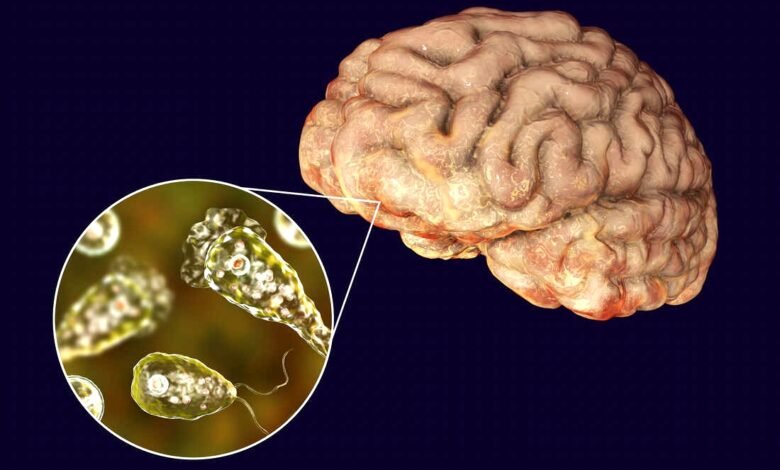Brain-Eating Amoeba (Naegleria fowleri): Causes, Symptoms, and Treatment

Naegleria fowleri, a.k.a (Brain-Eating Amoeba), is an amoeba that can cause a serious central nervous system infection. The amoeba is found in warm and still-fresh water bodies and enters the human body through the nose. Successful treatment has included miltefosine.
EXPLORE THE CONTENTS
OVERVIEW
What is a brain-eating amoeba (Naegleria fowleri)?
Naegleria fowleri is a species of amoeba found worldwide in warm, shallow bodies of fresh water, including lakes, rivers, and hot springs. It also inhabits soil. It is a free-living organism because it does not require a host in order to survive.
This amoeba causes a condition known as primary amoebic meningoencephalitis (PAM) when it infects humans. PAM is an extremely fatal infection of the central nervous system.
How does the brain-eating amoeba (Naegleria fowleri) get into your body?
The most common way for someone to get infected with this amoeba is when infected water passes through the nose. The amoeba then travels to the brain. This typically occurs when swimming, diving, or skiing in infected water. In rare instances, the infected water may be heated tap water or inadequately chlorinated swimming pool water.
Note: You cannot become infected by drinking contaminated water.
Is brain-eating amoeba (Naegleria fowleri) infection common?
Fortunately, there are only a handful of cases annually in the United States (estimated between zero and eight). Most cases occur in southern states, including Florida and Texas, and involve young men.
In recent decades, however, cases have occurred in northern states during extremely hot weather. This shift in infection locations may be a result of climate change.
Ongoing studies cast doubt on the rarity of Naegleria fowleri infection. Antibodies against the amoeba indicate that some individuals have been infected and survived. Some meningitis-related deaths have been reclassified as brain-eating amoeba (Naegleria fowleri)-related deaths.
Another question is why some people are not infected with the amoeba despite being in the same location and performing the same activities as those infected.
Related: Brain-eating amoeba kills a 2-year-old Nevada boy after a hot spring visit.
SYMPTOMS AND CAUSES
What are the symptoms of brain-eating amoeba (Naegleria fowleri)?
The signs and symptoms of primary amoebic meningoencephalitis (PAM) come on suddenly and are severe at the start, including:
- High fever.
- Very painful headache.
- Nausea and vomiting.
- Trembling.
- Symptoms like those of meningitis include a stiff neck and extreme sensitivity to light (photophobia).
- Mental confusion.
- Coma.
The fatality rate is higher than 97% even with treatment.
What are the Causes of brain-eating amoeba (Naegleria fowleri)?
The infection is caused when the amoeba Naegleria fowleri enters the brain via the nasal cavity. It can enter the body via inhalation of infected water. Typically, amoebas inhabit warm freshwater bodies, including hot springs (geothermal water).
Infection is also possible through inhalation of infected dust.
Other cases of brain-eating amoeba (Naegleria fowleri) infection have been attributed to people using tap water instead of distilled or sterilized water to rinse their noses with neti pots.
Incubation Period of this Infection Naegleria fowleri?
Symptoms begin to appear about two to fifteen days after exposure to the amoeba.
Is brain-eating amoeba (Naegleria fowleri) contagious?
No. There have been no reported instances of the infection spreading from person to person. There are currently ongoing studies to determine if the infection can spread through tissue or organ donation.
DIAGNOSIS AND TESTS
How is brain-eating amoeba infection diagnosed?
Suppose a healthcare provider suspects you have been infected with brain-eating amoeba (Naegleria fowleri). In that case, they will recommend a spinal tap, also known as a lumbar puncture, to determine whether the organism is present in your cerebrospinal fluid (CSF).
Your physician may also suggest a brain biopsy. During this procedure, a tissue sample will be extracted and examined under a microscope to detect the presence of amoeba.
TREATMENT
How is infection with brain-eating amoeba (Naegleria fowleri) treated?
The antifungal amphotericin B is the treatment of choice for primary amoebic meningoencephalitis (PAM) or infection with brain-eating amoeba (Naegleria fowleri). Some North American survivors were treated with amphotericin B, rifampin, fluconazole, and miltefosine. Miltefosine is a drug approved for treating leishmaniasis, a parasitic disease transmitted by sandflies.
The best outcomes in two children who fully recovered resulted from early diagnosis, treatment with the recommended drugs, and cooling the body below normal temperature to treat brain swelling.
PREVENTION
How can I Prevent Myself From being infected with brain-eating amoeba (Naegleria fowleri)?
Because the prognosis for this condition is so dismal, prevention may be crucial despite the condition’s rarity. These are essential details to remember:
- Avoid swimming, wading, and watersports without nose plugs in warm, freshwater locations, especially still waters. If Naegleria fowleri is known or likely present, avoid entering the water.
- Never use tap water in a neti pot or any other device to clean the nasal passages. Only use purified or distilled water. If you must use tap water, boil it for one minute before it cools. If you reside at 6,500 feet above sea level, boil the water for three minutes before it cools.
- Filters can be used to remove bacteria from water. Utilize filters with the markings “NSF 53,” “NSF 58,” or “absolute pore size of 1 micron or less.”
- Additionally, you can use chlorine bleach liquid or tablets to disinfect your water for nasal and sinus cleansing. When disinfecting water for nasal use, a different quantity of bleach is required than when disinfecting water for drinking.
- You should inform your healthcare provider if you develop a fever or a headache after swimming in warm freshwater.
PROGNOSIS
Brain-eating amoeba (Naegleria fowleri) infection prognosis?
A person infected with Naegleria fowleri has a very poor prognosis. Even with treatment, the majority of patients with this condition die. Typically, coma and death occur within a week or ten days of the onset of symptoms and signs.
LIVING WITH
When should I see a doctor if I have questions about brain-eating amoeba (Naegleria fowleri) infection?
Immediately consult a healthcare provider or go to the emergency room if you develop a fever or a headache after being active in a warm freshwater body of water or after irrigating your nasal passages with tap water. It is crucial to diagnose and treat brain-eating amoeba (Naegleria fowleri) infections as early as possible.
Message from the StoryMag
Hearing about a disease caused by a brain-eating amoeba and knowing how dangerous it can be is unsettling. If you believe you may have been exposed to the amoeba, seek medical attention immediately. However, it is essential to remember how uncommon this condition is. You can contribute to its prevention by rinsing your nasal passages with only distilled or sterilized water and avoiding water that you suspect may be contaminated, especially during hot weather.








One Comment